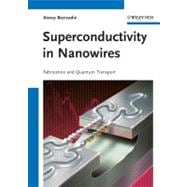
Note: Supplemental materials are not guaranteed with Rental or Used book purchases.
Purchase Benefits
What is included with this book?
Preface – Superconductivity and Little’s Phase Slips in Nanowires IX
Abbreviations – Short List XI
Notations – Short List XIII
Color Plates XV
1 Introduction1
2 Selected Theoretical Topics Relevant to Superconducting Nanowires 15
2.1 Free or Usable Energy of Superconducting Condensates 15
2.2 Helmholtz and Gibbs Free Energies 18
2.3 Fluctuation Probabilities 23
2.4 Work Performed by a Current Source on the Condensate in a Thin Wire 27
2.5 Helmholtz Energy of SuperconductingWires 29
2.6 Gibbs Energy of SuperconductingWires 31
2.7 Relationship between Gibbs and Helmholtz Energy Densities 35
2.8 Relationship between Thermal Fluctuations and Usable Energy 36
2.9 Calculus of Variations 38
2.10 Ginzburg–Landau Equations 39
2.11 Little–Parks Effect 46
2.12 Kinetic Inductance and the CPR of a Thin Wire 50
2.13 Drude Formula and the Density of States 51
3 Stewart–McCumberModel 53
3.1 Kinetic Inductance and the Amplitude of Small Oscillations 60
3.2 Mechanical Analogy for the Stewart–McCumber Model 62
3.2.1 Defining the Supercurrent Through Helmholtz Free Energy 65
3.2.2 Cubic Potential 66
3.2.3 Thermal Escape from the Cubic Potential 67
3.3 Macroscopic Quantum Phenomena in the Stewart–McCumber Model 68
3.3.1 MQT in a Cubic Potential at High Bias Currents 71
3.4 Schmid–Bulgadaev Quantum Phase Transition in Shunted Junctions 74
3.5 Stewart–McCumber Model with Normalized Variables 76
4 Fabrication of Nanowires Using Molecular Templates 79
4.1 Choice of Templating Molecules 86
4.2 DNA Molecules as Templates 86
4.3 Significance of the So-Called “White Spots” 88
5 Experimental Methods 91
5.1 Sample Installation 91
5.2 Electronic Transport Measurements 95
6 Resistance of Nanowires Made of Superconducting Materials 101
6.1 Basic Properties 101
6.2 Little’s Phase Slips 105
6.3 Little’s Fit 108
6.4 LAMH Model of Phase Slippage at Low Bias Currents 115
6.5 Comparing LAMH and Little’s Fit 122
7 Golubev and Zaikin Theory of Thermally Activated Phase Slips 125
8 Stochastic Premature Switching and Kurkijärvi Theory 131
8.1 Stochastic Switching Revealed by V–I Characteristics 131
8.2 “Geiger Counter” for Little’s Phase Slips 135
8.3 Measuring Switching Current Distributions 139
8.4 Kurkijärvi–Fulton–Dunkleberger (KFD) Transformation 143
8.5 Examples of Applying KFD Transformations 148
8.6 Inverse KFD Transformation 152
8.7 Universal 3/2 Power Law for Phase Slip Barrier 153
8.8 Rate of Thermally Activated Phase Slips at High Currents 157
8.9 Kurkijärvi Dispersion Power Laws of 2/3 and 1/3 160
9 Macroscopic Quantum Tunneling in Thin Wires 163
9.1 Giordano Model of Quantum Phase Slips (QPS) in Thin Wires 165
9.2 Experimental Tests of the Giordano Model 175
9.3 Golubev and Zaikin QPS Theory 183
9.4 Khlebnikov Theory 185
9.5 Spheres of Influence of QPS and TAPS Regimes 187
9.6 Kurkijärvi–Garg Model 189
9.7 Theorem: Inverse Relationship between Dispersion and the Slope of the Switching Rate Curve 195
10 Superconductor–Insulator Transition (SIT) in Thin and Short Wires 197
10.1 Simple Model of SIT in Thin Wires 207
11 Bardeen Formula for the Temperature Dependence of the Critical Current 213
Appendix A Superconductivity in MoGe Alloys 215
Appendix B Variance and the Variance Estimator 217
Appendix C Problems and Solutions 223
References 241
Index 247
The New copy of this book will include any supplemental materials advertised. Please check the title of the book to determine if it should include any access cards, study guides, lab manuals, CDs, etc.
The Used, Rental and eBook copies of this book are not guaranteed to include any supplemental materials. Typically, only the book itself is included. This is true even if the title states it includes any access cards, study guides, lab manuals, CDs, etc.